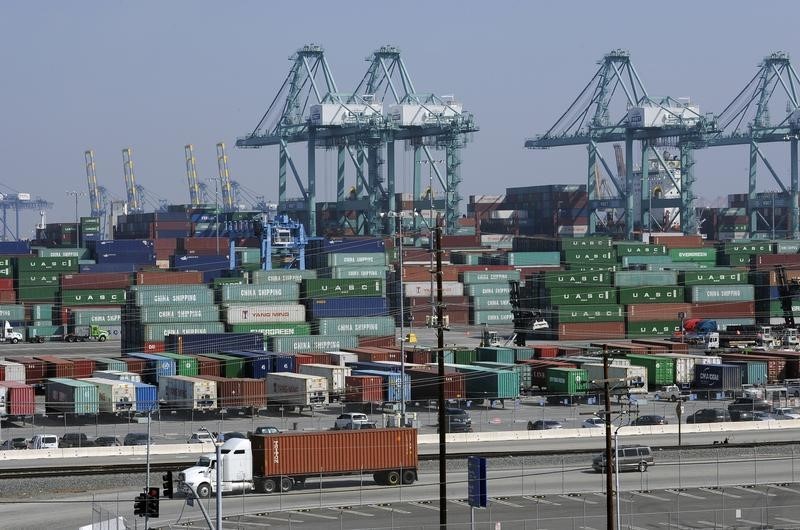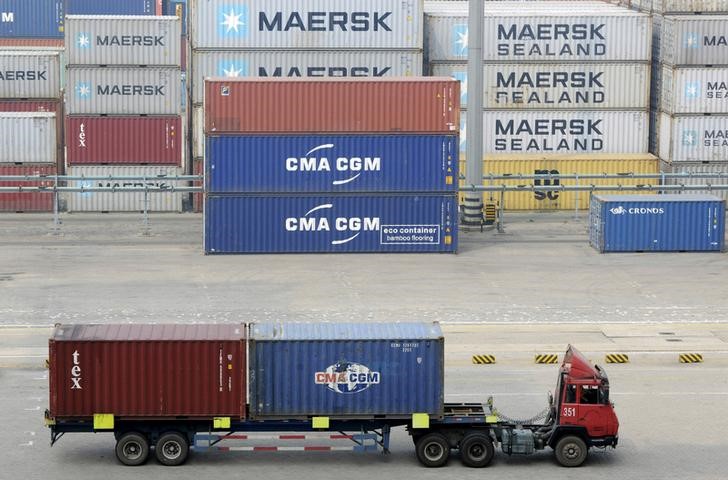By Lucia Mutikani
WASHINGTON (Reuters) - The U.S. goods trade deficit narrowed sharply to a one-year low in March, as both imports and exports fell, suggesting economic growth in the first-quarter was probably not as weak as currently anticipated.
The Commerce Department said in its advance report on Wednesday that the goods trade gap tumbled 10.3 percent to $56.90 billion last month, the smallest deficit since February 2015.
While the improvement suggested there could be an upside surprise in gross domestic product growth for the first quarter, the weakness in both imports and exports is worrying as it implies softening global and domestic demand.
"Notwithstanding the improvement in the deficit, which signals a diminished drag on domestic GDP, the broad-based falloff in both exports and imports activity is a sobering sign of some weakening in domestic and global demand," said Millan Mulraine, deputy chief economist at TD Securities in New York.
Goods imports fell 4.4 percent to $173.6 million last month, outpacing a 1.2 percent drop in exports. March's comprehensive trade report, which includes services, will be released next Wednesday. The advance goods trade data will be included in Thursday's snapshot of first-quarter GDP growth.
Economists polled by Reuters have forecast GDP rising at a 0.7 percent annual rate in the first three months of the year. The economy grew at a 1.4 percent rate in the fourth quarter.
The Federal Reserve on Wednesday left its overnight benchmark interest rate unchanged citing weak economic growth and tame inflation. The U.S. central bank's statement accompanying the decision implied that it was in no hurry to follow on from its December rate hike.
The dollar was trading weaker against a basket of currencies, but off earlier lows. Prices for U.S. government debt rose, while U.S. stocks trimmed losses.
UPSIDE RISK
"It (goods deficit) suggests that first-quarter GDP growth will be much stronger than we previously believed," said Paul Ashworth, chief U.S. economist at Capital Economics in Toronto.
"We now estimate that first-quarter GDP growth was 1.4 percent annualized, whereas we previously thought it would be only 0.8 percent."
Imports fell broadly last month, with consumer goods plunging 9.7 percent and capital goods declining 3.2 percent.
The economy has been hurt by the lingering effects of the dollar's rally last year and sluggish global demand, which have eroded exports. Weak business spending, especially in the troubled energy sector, and ongoing efforts by businesses to reduce an inventory overhang have also acted as a drag.
A separate report on Wednesday from the National Association of Realtors showed contracts to purchase previously owned homes rose 1.4 percent in March to a 10-month high. These contracts become sales after a month or two, and last month's increase pointed to a further pick-up in home resales in April.
Housing continues to be a bright spot in the economy, driven by a strong labor market. But a shortage of properties for sale, which is limiting choices for buyers and driving up prices, remains a constraint.

"The buying season is off to a good start that should ensure we indeed see the best year of total sales in a decade," said Jonathan Smoke, chief economist at Realtor.com in Washington.
